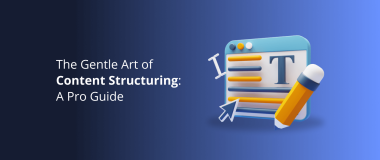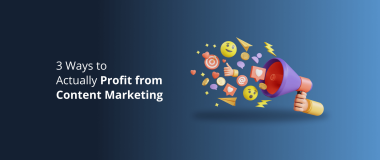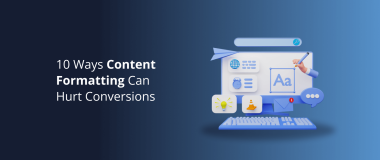Content creation is just the beginning of the digital marketing journey. To truly reach your target audience and convert them into customers, you need a well-crafted content distribution strategy.
The art of content distribution for Business-to-business (B2B) companies revolves around getting your content out, at the right time, and through the right channels.
In this article, we’ll delve into the three primary content distribution channels – Owned, Earned and Paid – while exploring various content types and the tools you can use to effectively distribute your content.
Owned Content Distribution Channels
Owned content distribution involves leveraging platforms and assets that you directly control. These channels are an excellent starting point for content distribution as they provide more control and flexibility.
Readers Also Enjoy: Step-by-Step Guide to Content Marketing for Business – DevriX
Blogs
Blogs are a common and effective type of owned content for businesses. They typically exist on a company’s website or a dedicated blogging platform and serve as an online platform to share valuable information.
The fundamental part of your blog are the content pillars – these are topics or themes around a brand’s content strategy. Content pillars serve as a roadmap for all content creation, ensuring that the brand’s messaging remains coherent and purposeful across various platforms and channels.
For example you can structure your tech B2B content strategy around these content pillars:
- Technology Trends/News. This pillar focuses on providing updates and analysis of the latest trends in the industry. Example content could include articles on the impact of AI on business processes or videos explaining the potential of blockchain in supply chain management.
- Product Tutorials and Guides. This pillar aims to educate potential customers about the company’s products and services. For instance step-by-step tutorials on using specific software or comprehensive guides explaining the features and benefits of various tech solutions offered by the business.
- Customer Success Stories. This pillar showcases real-life success stories and case studies of how the tech solutions provided by the B2B business have helped other companies achieve their goals.
Gated Content
Gated content refers to highly valuable digital resources or information that is accessible to users only after they provide some form of personal information, such as an email address or contact details.
This way businesses nurture leads and foster deeper connections with their audience. The most common goal of creating gated content is building an email list.
For instance, for B2B audiences, some best practices for creating gated content are:
- Newsletters. You can send regular emails, containing updates, news, or valuable content related to a specific topic.
- Landing pages. These are designed to convert visitors into leads or customers by presenting compelling offers, information, or calls-to-action tailored to a specific marketing campaign or goal.
- In-Depth Whitepapers. Whitepapers are often well researched and detailed documents that provide insights into industry trends, challenges, and solutions.
- Webinars and Workshops. Hosting webinars or online workshops led by industry experts can be a great way to connect with your audience.
- Exclusive Case Studies. Sharing success stories and case studies can demonstrate how your products or services have helped other companies achieve their goals.
- Research Reports. These reports offer up data-driven insights that can help businesses make informed decisions.
- Toolkits and Templates. Practical toolkits, templates, or checklists often provides professionals with what they need to streamline their processes.
- Exclusive Access to Software or Tools. A practical and very appreciated practice is to offer limited-time access to premium software or tools, relevant to your audience’s needs.
- Industry Benchmarking Reports. By offering benchmarking reports that compare industry performance, you allow B2B companies to measure their progress against one another.
- Expert Interviews and Q&A Sessions. Interviews with industry thought leaders or Q&A sessions are another good way to connect with your audience.
- Exclusive Product Demos. Providing access to exclusive product demos, showcases how much you value your clients.
- Courses and Training Materials. Developing educational courses or training materials can help B2B professionals enhance their skills and knowledge.
Readers Also Enjoy: The Advanced Guide to Content Marketing – DevriX
Social Media Profiles
Social media profiles are a key component of owned content for businesses. These profiles exist on various social media platforms like Facebook, Twitter, LinkedIn, Instagram, and others.
They serve as digital representations of the brand, providing a space to engage with the target audience, share updates, and build a community around the brand’s products or services.
Some examples for creating social media content for B2B audiences include:
- Exclusive Webinars and Live Sessions. Host gated webinars or live sessions to attract a targeted audience and collect leads.
Example: A B2B software company organizing a gated LinkedIn Live session on “Digital Transformation Strategies for Enterprises.” - Downloadable Resources. Offer gated downloadable resources in exchange for contact information. For instance a marketing agency sharing a gated Facebook post with a link to download an ebook on “B2B Lead Generation Techniques.”
- Posts/Snippets. Share industry snippets of valuable content on social media, encouraging users to click through to access the full resource.
Example: A B2B consulting firm posting a gated infographic on “Emerging Market Trends in the IT Sector” with a link to the full report. - Sneak Peeks and Previews. Offer exclusive sneak peeks or previews of upcoming products, services, or events to create curiosity and capture leads.
Example: An event management company providing an Instagram Stories preview of a forthcoming industry summit. - Contests and Giveaways. Run gated social media contests where participants must provide their contact details to enter, expanding your email list.
Example: A B2B hardware manufacturer hosting a gated Twitter contest to win a new product sample. - VIP Access to Resources. Offer access to premium content for users who sign up or follow the social media profile.
Example: A B2B financial services company providing gated access to specialized financial analysis content for LinkedIn followers.
Mobile Apps
Mobile apps are a form of owned content that businesses can create and offer up to their audience through app stores (e.g., Apple App Store, Google Play Store). These apps serve as a direct channel for businesses to engage with their customers or clients on their smartphones or tablets.
Mobile apps can provide various functionalities, including access to products and/or services, valuable content, exclusive features, and personalized experiences. All of which contributes to improved customer engagement and brand loyalty.
Content Distribution Tools for Owned Channels
There are plenty of content distribution tools (free and paid) that can streamline the process of reaching a wider audience, boosting engagement, and maximizing the impact of your content marketing efforts.
Just a few examples:
- WordPress. The best content management system (CMS) that allows you to publish and share blog posts efficiently.
- Email marketing platforms such as Mailchimp offer email automation, customizable templates, audience segmentation, A/B testing, and detailed analytics, making it suitable for businesses of all sizes.
- Social media scheduling tools such as Buffer or Later distribute owned content across multiple social media platforms, including Facebook, Twitter, LinkedIn, and Instagram.
- Canva. An intuitive design tool that lets you create infographics, social media graphics, and other visual content.
- PDF sharing platforms. Websites like SlideShare and Issuu are ideal for sharing ebooks and guides with a broader audience.
Readers Also Enjoy: eCommerce Content Marketing: Creating Content That Drives Sales – DevriX
Earned Content Distribution Channels
Earned content distribution focuses on the content that others create or share about your brand or content. It involves building a reputation and the authority to attract organic promotion from your audience and industry peers.
Content Types for Earned Distribution
These types encompass organic forms of content promotion:
- User-Generated Content (UGC). Encourage your B2B audience to create and share content related to your innovative products, industry solutions, or how they use your services to solve business challenges.
Example: A B2B software company’s social media campaign, inviting customers to share their success stories or creative ways they’ve implemented the company’s software into their business processes. - Guest Posts. Guests can contribute valuable content that earns you exposure and backlinks.
- Press Mentions. Third party mentions in publications or media outlets not only highlight your brand’s expertise but it showcases your achievements as well.
Example: A tech startup featured in a technology magazine.
Content Distribution Tools for Earned Channels
These tools are extremely useful if a brand wants to widen their exposure and grow their reputation:
- Social Media Monitoring Tools. Tools like Sprout Social help you track mentions and engagement across various social media platforms.
- BuzzSumo. Identifies popular content in your industry to see what resonates with your target audience, aiding your overall content strategy.
- Media Database Services: Platforms like Cision and Meltwater can help you with your press outreach efforts.
Paid Content Distribution Channels
Paid content distribution means that you are investing in advertising and promotion to reach a wider audience quickly. While it requires a budget, it can offer substantial returns if executed properly.
Content Types for Paid Distribution
Paid Distribution involve leveraging paid advertising on various platforms to promote and distribute content:
- Social Media Ads. Promote your content through paid advertising on platforms like Facebook, Instagram, and Twitter to reach a targeted audience.
- Google Ads. Utilize Google’s advertising platform to display your content in search results or on relevant websites through display ads.
- Sponsored Content. Partner with influencers or popular websites to have them publish content that features your brand.
Content Distribution Tools for Paid Channels
These tools are indispensable assets that assist businesses in managing and optimizing their paid advertising efforts:
- Facebook Ads Manager. Manage and track your Facebook and Instagram ad campaigns in one place with this powerful tool.
- Google Ads. Create and optimize your Google ads to drive traffic and conversions.
- Influencer Marketing Platforms. Platforms like AspireIQ and Influencity help connect brands with relevant influencers for sponsored content collaborations.
Wrap Up
If you understand the three different content distribution groups – Owned, Earned and Paid – you can effectively reach your audience and expand further into the market.
You can engage with your audience and provide them a consistent and valuable service. Make sure you track your data, analyze the results and adapt to the changes and you will be on top of the market in no time.
To enhance your content distribution strategy and achieve remarkable results, leverage DevriX‘s expert services for tailored solutions and support. Reach out to us to take your business to new heights!




